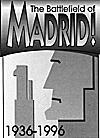 The battle of Madrid has been described as the central epic of the Spanish Civil War. Presented as a dramatic clash between fascism and democracy, or between Christianity and
Bolshevism, according to taste, it seized the imagination of the whole of Europe. Yet in Spain
today it is almost forgotten. Even educated Spaniards are barely aware of the location of
the fighting or the course of events, whilst on what remains of the battlefield, young couples
make love in convenient hollows that they are quite unaware are actually shell holes.
The battle of Madrid has been described as the central epic of the Spanish Civil War. Presented as a dramatic clash between fascism and democracy, or between Christianity and
Bolshevism, according to taste, it seized the imagination of the whole of Europe. Yet in Spain
today it is almost forgotten. Even educated Spaniards are barely aware of the location of
the fighting or the course of events, whilst on what remains of the battlefield, young couples
make love in convenient hollows that they are quite unaware are actually shell holes.
Yet, as this article will attempt to show, there is much to be seen by the observant visitor who is prepared to turn his back on the usual tourist sights of the city and get off the beaten track. Before looking at the battlefield, however, we must first examine the events of the battle itself, the consequence being that this article will be written in two parts, the first of which look at the battle and the second at the battlefield.
Without going into too much detail, the Spanish Civil War broke out in July 1936 following a military coup designed to block the programme of reform presaged by the victory of the moderately left-wing government of the Popular Front in general
elections five months earlier. Intended to produce a rapid seizure of power throughout Spain, the coup was in the event only partially successful, and the country was divided into two armed camps, which were initially quite evenly matched.
However, within a very short period, the pendulum had swung very much in favour of the
Nationalists, as the rebels became known. Ironically (given that it was supposed to protect Spain from such a development), the Nationalist uprising had sparked off a massive revolution in the Republican zone, and such forces as had remained loyal to the government had either been
incapacitated or had simply fallen apart, their place having been taken by a motley collection of political militias.
Meanwhile, under the tough and uncompromising command of General Franco, the regular units controlled by the Nationalists had been strengthened and used as the cadre for a much expanded army, weapons and ammunition had been carefully husbanded rather than being squandered and dispersed, and the various fascist and monarchist political militias brought under military control. At the same time, with the aid of a number of aircraft hastily begged from Hitler and Mussolini, the elite foreign legionaries and Moorish auxiliaries of the garrison of Morocco, which had rallied to the uprising in its entirety, had been brought over to reinforce the Nationalists' originally rather precarious toehold in Andalucia.
As a result the Republican cause quickly suffered a series of major defeats, with parts of the country quickly being conquered by the rebels. To win the war quickly, all that seemed necessary was to capture Madrid as quickly as possible, and by the middle of August a Nationalist army was driving eastwards up the Tagus valley in the direction of the capital (this force was initially organised in four 'columns', or brigades; hence the emergence of the term 'fifth column').
The so-called march on Madrid that followed was hardly encouraging for the Republic. Very few
Nationalist troops were actually available for the campaign - initially no more than 5000 men - and even these were not especially well-armed. However, they did have the advantage of mobility,
sufficient vehicles having been commandeered in Seville and other cities for the entire force to be mounted in trucks and buses. At the same time a substantial amount of air support was available from the ninety or so bombers and fighters that had by now been received from Germany and Italy, plus the hotch-potch of Nieuports and Breguets that had fallen into rebel hands in July (by the middle of September the Nationalists seem to have received 20 He46 reconnaisance aircraft, 9 SM81 and 24 Ju52 bombers, and 15 He51 and 21 Fiat CR32 fighters).
As a result, the much larger Republican forces in the Tagus valley were repeatedly outflanked and forced to retreat, and their counterattacks, including one on Wellington's old battlefield at Talavera, beaten off with heavy losses. By the end of September, the Nationalists had relieved the besieged outpost of the Alcazar de Toledo, where a rebel garrison had held out since the uprising, absorbing considerable Republican resources in the process. Some days
were lost in this operation - a factor that is often counted of some importance in subsequent
events but October saw the Nationalists on the march again, this time heading due north for
Madrid. Progress was now much slower. The Nationalist forces were extremely tired, and,
despite considerable reinforcement, more outnumbered than ever; the Republicans, meanwhile, had constructed a series of well-fortified defensive lines barring the approaches to the capital, and, strengthened by the delivery of modern armoured cars, tanks and aircraft from Russia, launched a series of ferocious counterattacks - but by the end of the first week of November the Nationalists had reached the southernmost outskirts of the city.
Battle of Madrid
The scene was now set for the battle of Madrid. Grouped together in the southernmost outskirts of the city around the military base of Campamento and the airfield of Getafe, the Nationalist assault forces numbered some 10,000 men organised in five brigades or columns,
each consisting of one battalion of the Foreign Legion and two half-battalions of Moorish regulares (there were other forces covering the flanks as well, but, even so, the whole amounted to no more than 15,000 men).
In support of the assault troops, the majority of whom were seasoned Moors and Foreign Legionaries, there was one company of Italian L.3 tankettes, including a section of the flame thrower version, two of German PzKpfw lAs, and one of Spanish 'Bilbao' armoured cars, five 3-gun batteries of 37 mm Pak 36 anti-tank guns, three two-gun batteries of Italian 65 mm M13 infantry guns intended for use in an anti-tank role, one battery of 20 mm Flak 30 anti-aircraft guns, and eighteen artillery batteries, each of four guns (viz. five batteries 65mm M13, five batteries 75 mm Schneider M06, four batteries 105 mm Vickers M22, four batteries 155 mm Schneider M1817).
Meanwhile, the arrival of ten Ro37 reconnaisance aircraft and another forty or so He51s and
CR32s had increased the number of aircraft available to well over 100. Facing them in the front line were about 13,000 Republican militia,supported by a few old Renault FT17s and Bilbaos of the pre-war army, a variety of improvised armoured lorries, approximately 80 Russian T26 tanks and BA6 armoured cars, all of them armed with 45 mm guns, forty-five artillery pieces, and several armoured trains.
Needless to say, such detachment is easy sixty years after the event. In the Madrid of November 1936 it would have been impossible. For all the boasts of the various left-wing political movements - the Socialists, the Communists and the Anarchists - that Madrid would prove the grave of fascism, it seemed that the Nationalist offensive was invincible, matters
not being helped by the fact that the government abandoned the capital for Valencia on 6 November, leaving the city in the hands of a junta of defence headed by the commander of the forces on the Madrid front, General Jose Miaja. The city was clogged with refugees, many of the
defenders were demoralised and exhausted, and the authorities were in a state of complete confusion. It is often claimed, particularly on the left, that Madrid was saved by the heroism and commitment of its own population, but such a claim is hard to sustain.
Certainly, Communists, Anarchists and Socialists alike vied with one another in a massive
propaganda campaign designed to mobilise the population; certainly, again, many madrilenos,
albeit for the most part mostly party militants, volunteered for the front, helped dig trenches and build barricades, or were otherwise actively involved in the struggle; certainly, yet again, the poorer districts of the capital, at least, were solidly pro-Republican. However, the effect of all this is, at best, intangible, and one cannot but wonder what really would have happened had the Nationalists ever broken through. And, if they did not, the reason was in large part a a healthy dose of luck combined with the aggressive posture from the start adopted by Miaja's Chief-of-Staff, Major Vicente Rojo.
Thus, when the Nationalists launched their assault on the early morning of 7 November 1936, their plan called for two of their five brigades those of Barron and Tella - to drive
directly northwards through the cluster of villages, slums and shanty towns scattered between the Campamento-Getafe area and the Puente de Toledo over the river Manzanares. However, this
advance was essentially to be a holding attack that would distract the attention of the defenders from the main thrust. This would rather come from a third brigade - that of Castejon - that, followed by the brigades of Asensio and Delgado, would strike northwards through the old royal hunting park of the Casa de Campo to the vicinity of the Puente de los Franceses railway bridge, where it would cross the river and advance through the open ground afforded by the Parque del Oeste and the brand-new campus of the university of Madrid - the Ciudad Universitaria thereby completely outflanking the defenders.
Reaching the district known as La Moncloa, it would then be able to advance down the major
arteries that lead from that point into the heart of the city. Clever though this plan was, however, things immediately went badly wrong.
Tella and Barron made some progress, albeit in the face of desperate opposition, but, just as Castejon's men were getting moving, they were thrown into complete confusion by a sudden Republican counterattack from the northwest. Beaten off though this was, their commander was wounded, whilst they were in consequence so much delayed that by the end of the day they had advanced no further than the southern edge of the Casa de Campo. Worse was to come: in the narrow streets and alleys of the slum districts round Carabanchel, the Nationalist tanks supporting Tella and Barron were at a serious disadvantage, and a number were knocked out by dynamite, petrol bombs or grenades (or, to put it another way, as a foreign newsman who asked a miliciano how he had blown up the tank he was credited with destroying was told, 'With balls').
One such casualty was the command-tank of the L.3 company. Captured by its assailants, this was found to contain a large packet of official papers. Inspected by the Republican high command, these proved to be nothing less than the Nationalists' complete plan of operations,
the night of 7 November in consequence witnessing frantic efforts to reinforce the Casa de Campo and to deploy strong reserves in its rear.
Lost Battle
To all intents and purposes the battle was now lost for the Nationalists. Given the superior resources of the Repubicans, their only hope had been to seize the city immediately. Denied a quick victory by the events of 7 November, they were now locked into a struggle of attrition from which they were unlikely to emerge victorious. This, however, is not to say that the
defence did not have some alarming moments in the days that followed, of which by no means the least difficult came the very next day.
Thus, on 8 November, whilst Tella and Barron fought their way forward house by house through Carabanchel, Castejon's men - now commanded by a Colonel Bartomeu - broke into the Casa de
Campo and had by the end of the day reached the line of the main railway to the north and captured the dominant height of Garabitas. Yet, despite the arrival of a new brigade under Siro, which was deployed on the Paquillo sector on the southern edge of the Casa de Campo, thereafter progress slowed once again.
Siro, Tella and Barron became completely bogged down a mile or so south of the Manzanares; every attempt of Delgado to eject the Republicans from the positions that they still held on the
eastern fringes of the Casa de Campo was beaten back; and the repeated efforts of Bartomeu and Asensio to seize the Punte de los Franceses and the adjacent Puente Nuevo road bridge and to get across the river in the Parque del Oeste sector - where, unlike further south, the river did not run in a steep-sided canal, but was rather broad and shallow - were mown down with heavy
losses. Virtually surrounded, the Nationalists in the Casa de Campo were constantly shelled and bombed - Garabitas was described by one observer as looking like a volcano - and, in addition, had simultaneously to fend off repeated Republican counterattacks from the north and north-west.
Desperate to relieve the pressure on them, meanwhile, the Republicans were also launching repeated attacks on the Nationalist right flank as well, the Cerro de los Angeles - the conical
hill that is reputed to be the geographical centre of Spain - being the site of particularly vicious fighting. As a result, the few reserves available to the Nationalists had for the most part to be deployed to protect the flanks of the assault troops rather than being used to reinforce them.
The fact was that the balance was now tipping firmly against the Nationalists. Always limited in strength, their forces were depleted by heavy casualties and increasingly exhausted. In the air, the new Russian fighters soon proved that they had the edge over their Nationalist opponents, and began to inflict serious casualties on bombers and fighters alike, insult being
added to injury by the fact that damaging raids were mounted on the airfields at Avila and
Talavera. As for the repeated raids that the Nationalists launched on the poorer areas of
Madrid in the hope demoralising the populace, these were damaging, certainly-between 14 and
23 November there were 1,119 civilian air-raid casualties but the military situation was altered not a whit.
All the more was this the case as the defence of the city simply did not depend upon its
population. As the days wore on, more and more reinforcements had been arriving in Madrid from
outside, but these were for the most part no longer the motley militia columns of earlier days, but representatives of a new and far more effective force. Realising that the militia 'system' was no way to win a war and at the same time determined to bring the revolution under control, the government had, with Communist help and encouragement, since October been trying to organise a new regular army. Though often little better armed and equipped than before, this new force was at least organised on a conventional basis - i.e in standard battalions, brigades and, eventually, divisions - and was therefore capable of fighting in a far more effective manner. As November progressed, so the first of its brigades to become available for service were rushed to the Madrid front, at least seven such units being available for service by the middle of the month.
The International Brigades
Prominent amongst these new troops, of course, were the first two representatives of the
famous International Brigades, which were made up of foreign anti-fascist - i.e. for the most part Communist - volunteers. Both at the time and since.
Much was made of the arrival of these troops, and it has often been claimed that they saved the city. This is not the case, however. Although undoubtedly brave and well-motivated, aside
from numbering no more than 3,500 men between them, they were neither well-armed, nor well-equipped, nor well-trained, the two brigades sent to Madrid - the XI and XII - having in fact been flung together only days before.
John Sommerfield, who was a machinegunner in the Xl brigade, describes how he and his fellows were issued with clothing and equipment in such a manner that 'everybody got
something and no-one everything', how his battalion was only issued with rifles- 7.62 mm
Moisin-Nagants M1891 manufactured in the United States for the Tsarist army in on the very day they left the front, and how the machine gun company only got its guns - the heavy, complicated
and hopelessly unreliable St. Etienne M1907 when it actually arrived in Madrid.
Much the same sort of experience is retailed by Esmond Romilly, who fought as a rifleman in the XII Brigade and is scathing of the training offered the volunteers to boot. At all events, when the XI Brigade arrived on 8 November there was no triumphal march across the city of the sort often mentioned - Sommerfield rather describes a plodding, dispirited progress through empty streets and, if the XI Brigade for the next few days fought bravely in the series
of counterattacks mounted on the northern flank of the Casa de Campo, it was clearly never involved in the crucial fighting round the Puente de los Franceses.
As for the XII Brigade, apart from a singularly inglorious attack upon the Cerro de los
Angeles on 13 November, it did not take part in the battle at all until 20 November when it was sent to reinforce the XI Brigade on the northern side of the Ciudad Universitaria.
Mention of the International Brigades probably dictates some reference to the foreign forces who fought for Franco, about which this article has so far said very little. If that is so, it is because there is relatively little to say. As has already been mentioned, by the time of the assault on Madrid, the Nationalists had received a considerable number of German and Italian
aircraft, but many were flown by Spaniards, and neither the Germans nor the Italians yet had a separate airforce of their own of the sort that they were soon to deploy (officially both flew as part of a hastily-formed aviation section of the Spanish Foreign Legion).
Condor Legion
Angered by Nationalist incompetence, however, in October the Germans had determined to form an independent air corps of their own that would be entirely under their control, the result being the formation of the famous Condor Legion early in November 1936. Consisting initially of 20 Ju52s, 14 He51s, and 6 He45s, all of them sent freshly from Germany, this constituted a major
reinforcement, but does not seem to have been deployed on the Madrid front until the very end of the battle.
Meanwhile, its Italian counterpart, the Aviazzione Legionaria, was not formed until the following month. As for ground troops, at this stage hardly any Germans or Italians were involved. All the Pz Is and L.3s were at least partly manned by Spaniards, as were
the 38 65/17 guns dispatched from Italy, whilst the thirty-odd 20 mm A.A. and 37 mm. A.T. guns received from Germany were wholly crewed by them. Plenty of munitions and small-arms, had
been sent to the Nationalists, meanwhile, but, as for heavier weapons, the mentions
that one comes across of German and Italian heavy artillery, for example, are the fruit of
pure fantasy: at this stage, neither power had dispatched anything of the sort.
To return to the reinforcements being received by the Republicans, if the XI and XII Intenational Brigades were rather less impressive than their press suggests, they were
undoubtedly of rather more use than the column of 1,500 Anarchist militia who appeared in the city after having been transferred from the Aragon front on 14 November.
The battle, then, was not going favourably for the Nationalists. However, this did not lead to any slackening of their efforts. On 15 November, notwithstanding desperate resistance, a renewed offensive spearheaded by all the Nationalists' Pz Is finally secured a bridgehead across the Manzanares just north of the Puente de los Franceses, the assault troops then pushing
up the steep hillside overlooking the river to occupy the first buildings of the Ciudad
Universitaria.
During the night fresh troops, including the XI International Brigade and the Durruti column, were immediately rushed in to seal the breach in the Republican front and drive the Nationalists back across the river. With regard to the latter task, the main role was given to Durruti. To give his men credit, they fought bravely - according to a Nationalist volunteer in one of the units they faced, they came to within thirty yards of the enemy positions - but, as even
Durruti's adjutant, Ricardo Sanz, was later forced to admit, they were eventually driven
back in disorder.
End of the Counterattack
With the Republican counterattack at an end, the tiny handful of Nationalist troops who had got across the river thus far began again to move forward supported by a thunderous artillery
bombardment and heavy bombing raids. Desperate resistance by the XI International Brigade notwithstanding, by the end of the day several other university buildings had in consequence also been occupied, including the French cultural institute known as the Casa de Velazquez -
where a company of Poles died to the last man - and the faculties of architecture and agronomy. Badly outnumbered and attacked from all sides, the ationalists nevertheless succeeded in extending their positions the following day as well, occupying yet more schools and faculties including, most importantly, the ground floors of the as-yet-unfinished shell of the Hospital Clinico (situated on a commanding height, this enormous complex of buildings dominated the whole area, whilst also being situated on the very edge of the city itself).
Ever since the crossing of the river, the fighting in the Ciudad Universitaria had been
extremely desperate with room-to-room and floor-to-floor fighting in the university
buildings, and repeated charges and counter charges across the empty paramos that surrounded them, but fighting now mounted to a crescendo. Trapped in its upper storeys, the remaining defenders of the Hospital Clinico died to the last man, some of them flinging themself from its
windows rather than surrender, whilst the Republicans sought frantically to win back the lost ground, with fighting even spreading to the sewers.
Once again, however, they failed, the Nationalists even being able to extend their positions to include the Palacete de la Moncloa (today the official residence of the prime minister), which was adjacent to the Ciudad Universitaria on its northern flank. More than that, however, even they could not do: on 22 November a last-ditch attempt was made to break through into the city-proper across the Parque del Oeste, but this proved a failure. Hit by a hurricane bombardment and saturation bombing, the Republican defenders in the path of the attackers disintegrated in panic and for a moment the Nationalists seemed to have broken through.
Part 2: The Battle of Madrid (1936) (Vol. 1 #6)
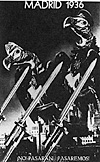 The Fifth Column
The Fifth Column
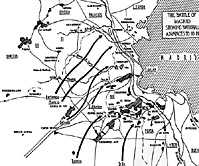 Larger version of Map at right (113K).
Larger version of Map at right (113K).
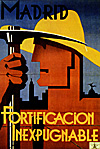 Ready to take to the air above them were something over fifty aircraft, the majority of them now modern Russian Polikarpov 115 and 116 fighters and Tupolev SB2 light bombers. On the whole the balance was remarkably even: if the Republicans had the advantages of strong defensive positions - for Madrid is situated on a bluff high above the valley of the river Manzanares, which is for much of its length canalised and unfordable, and was protected to the south on the one hand by a sprawling belt of working-class suburbs and on the other by the thickly-wooded hills of the Casa de Campo - better tanks and aircraft, and superior numbers (for the 13,000 men in the front line were supported by at least 10,000 fresh troops in reserve, whilst many other could be summoned from elsewhere). The Nationalists were blessed with better morale, organisation, leadership and training.
Ready to take to the air above them were something over fifty aircraft, the majority of them now modern Russian Polikarpov 115 and 116 fighters and Tupolev SB2 light bombers. On the whole the balance was remarkably even: if the Republicans had the advantages of strong defensive positions - for Madrid is situated on a bluff high above the valley of the river Manzanares, which is for much of its length canalised and unfordable, and was protected to the south on the one hand by a sprawling belt of working-class suburbs and on the other by the thickly-wooded hills of the Casa de Campo - better tanks and aircraft, and superior numbers (for the 13,000 men in the front line were supported by at least 10,000 fresh troops in reserve, whilst many other could be summoned from elsewhere). The Nationalists were blessed with better morale, organisation, leadership and training.
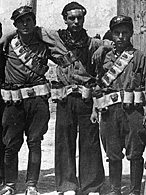 Commanded by the veteran Anarchist leader, Buenaventura Durruti, these troops radiated
revolutionary bravado - they were much given to posing 9at right) with sticks of dynamite -but in fact their record in the fighting in Aragon had been distinctly unimpressive, and they were to prove of little use. Of far more value than either Internationals or Anarchists, in fact, was
the arrival of considerable fresh artillery, the number of guns assigned to the defence soon rising to at least 80; much better organised than before, in the form of the Telephone Building- Madrid's only skyscraper - this force also also had an ideal observation post.
Commanded by the veteran Anarchist leader, Buenaventura Durruti, these troops radiated
revolutionary bravado - they were much given to posing 9at right) with sticks of dynamite -but in fact their record in the fighting in Aragon had been distinctly unimpressive, and they were to prove of little use. Of far more value than either Internationals or Anarchists, in fact, was
the arrival of considerable fresh artillery, the number of guns assigned to the defence soon rising to at least 80; much better organised than before, in the form of the Telephone Building- Madrid's only skyscraper - this force also also had an ideal observation post.
 However, as they emerged from the trees of the park into the open Plaza de la Moncloa, they were cut down by withering fire from Republican troops hidden in the ruins of the prison
that then stood on its southern side, and this, together with a dramatic personal appearance by
General Miaja, sufficed to turn the tide. As a result, all that the Nationalists obtained from the day was a shallow lodgement was obtained in the northwestern fringes of the Parque del Oeste. Recognising the inevitable, the very next day Franco ordered the attempt to take Madrid by storm to be brought to an end. The fighting was not over - in three successive campaigns between December 1936 and March 1937 the Nationalists were to seek to take the capital by cutting it off from the outside world, whilst Madrid was to be bombed and shelled for the rest of the war, but the actual battle of Madrid was at an end.
However, as they emerged from the trees of the park into the open Plaza de la Moncloa, they were cut down by withering fire from Republican troops hidden in the ruins of the prison
that then stood on its southern side, and this, together with a dramatic personal appearance by
General Miaja, sufficed to turn the tide. As a result, all that the Nationalists obtained from the day was a shallow lodgement was obtained in the northwestern fringes of the Parque del Oeste. Recognising the inevitable, the very next day Franco ordered the attempt to take Madrid by storm to be brought to an end. The fighting was not over - in three successive campaigns between December 1936 and March 1937 the Nationalists were to seek to take the capital by cutting it off from the outside world, whilst Madrid was to be bombed and shelled for the rest of the war, but the actual battle of Madrid was at an end.
Back to Battlefields Vol. 1 Issue 5 Table of Contents
Back to Battlefields List of Issues
Back to Master Magazine List
© Copyright 1996 by Partizan Press.
This article appears in MagWeb (Magazine Web) on the Internet World Wide Web.
Other military history articles and gaming articles are available at http://www.magweb.com